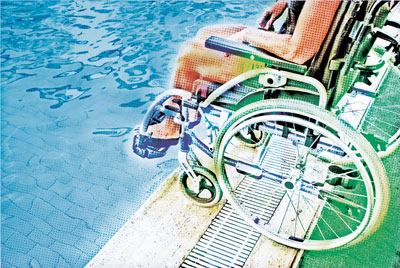When the Americans with Disabilities Act standards compliance deadline of March 15 was originally announced, some professionals likened it to the Virginia Graeme Baker Pool and Spa Safety Act.
But unlike that federal law, the ADA has not fueled an overwhelming rush to meet the deadline. What’s more, service technicians seem reluctant to do the work.
As of press time, industry professionals were not widely reporting a barrage of inquiries from aquatics facilities. Some did start to trickle in, but there hasn’t been as much activity as would be expected.
Aquatics professionals have been aware of the ADA deadline since 2010, when the U.S. Department of Justice finalized the Standards for Accessible Design, which includes specifications for pool and spa access. Most public pools must have a sloped entry or lift, and those measuring more than 300 perimeter feet need a second means of access. Spas must have a lift, transfer wall or transfer system. Facility managers are discouraged from using the same mechanism twice.
While the deadline for new pools and spas was last year, this month’s deadline applies to existing facilities. Some don’t see that as a hard and fast rule; however, because the standards state that certain facilities could pass muster with a documented plan showing how the retrofits would take place over time.
After a year with few inquiries, managers of some facilities, particularly hotels and motels, are beginning to approach pool professionals. But not many go past the bid stage.
“We’ve had people call us and say, ‘Are we or are we not in compliance? We own 50 sites. Can you give us a price?’” said Mitch Friedlander, CEO/president of American Pool Enterprises in Owings Mills, Md. “We’ll price it, and all of a sudden now we hear crickets.”
Many believe this reluctance springs from the lack of an enforcement mechanism. The justice department doesn’t plan to conduct inspections or become involved unless complaints or lawsuits are filed, though states and municipalities have the option of enforcing it voluntarily.
“It’s almost like an honor system, and with the properties going through the economy we’ve just experienced, I think they’re dragging their feet,” Friedlander said.
In addition, many facilities still are feeling the frustration of VGB, with its urgent deadlines, product recall and sudden changes in requirements. Few are in a hurry to embrace yet another regulation.
“Everybody is frustrated,” said Alison Osinski, president of Aquatic Consulting Services in San
Diego. “They’re asking, ‘Is this going to change again?’ I’m hearing that they have no money in the budget, and they’re still complaining about VGB issues.”
Because of their lower cost and lack of intrusion to the pool structure and surrounding deck, lifts are expected to be the most popular choice. What’s more, price-shopping property owners reportedly are attempting to purchase lifts directly from manufacturers or distributors, or via the Internet. Service and construction firms then may be asked merely to install the lifts, or be forced to sell them near cost.
“If we could turn around and sell the lifts for [a decent profit], life is good and sign me up,” said Javier Payan, president of Payan Pool Service in El Cajon, Calif. “But I think the margins are going to be tight. And with the insight that we gained from the VGB days, why would you want to sign up for that?”



